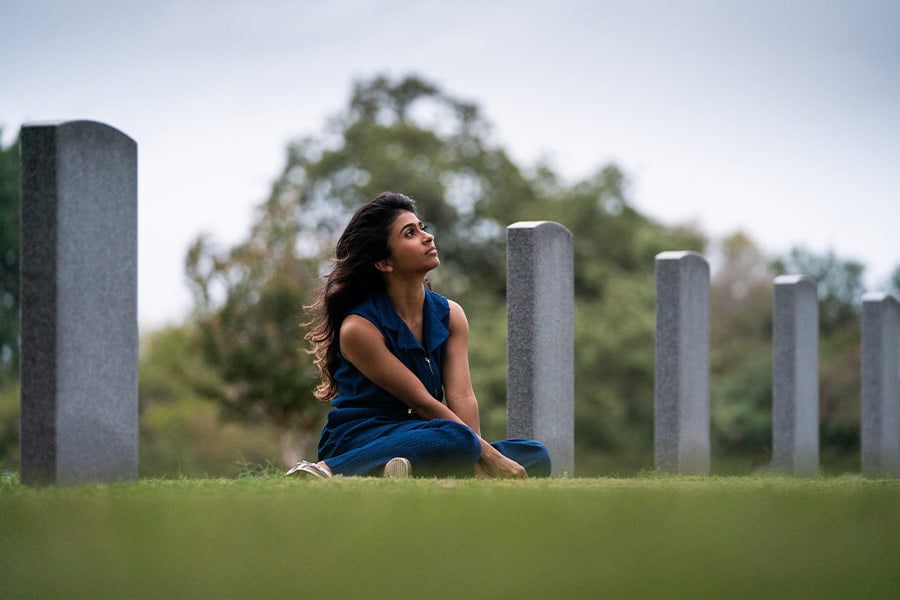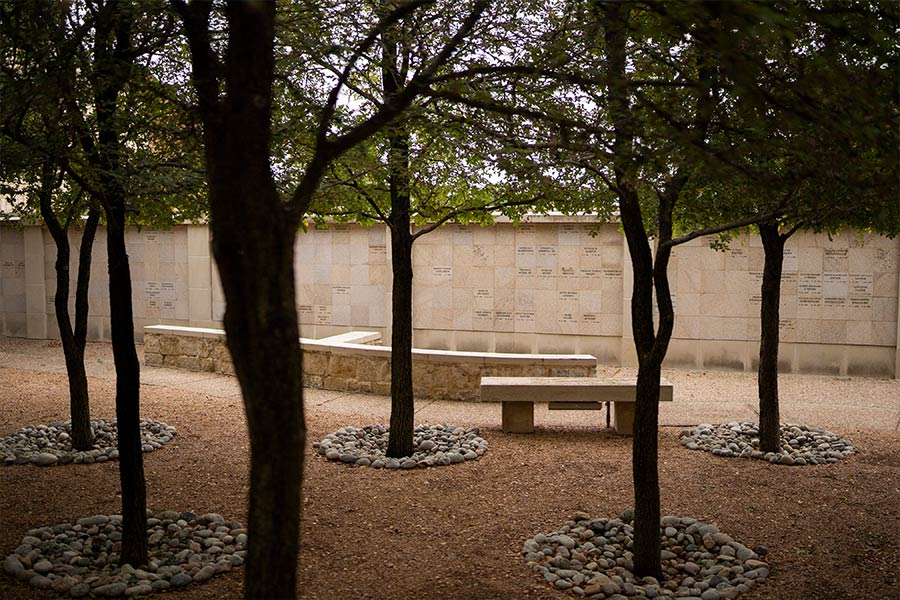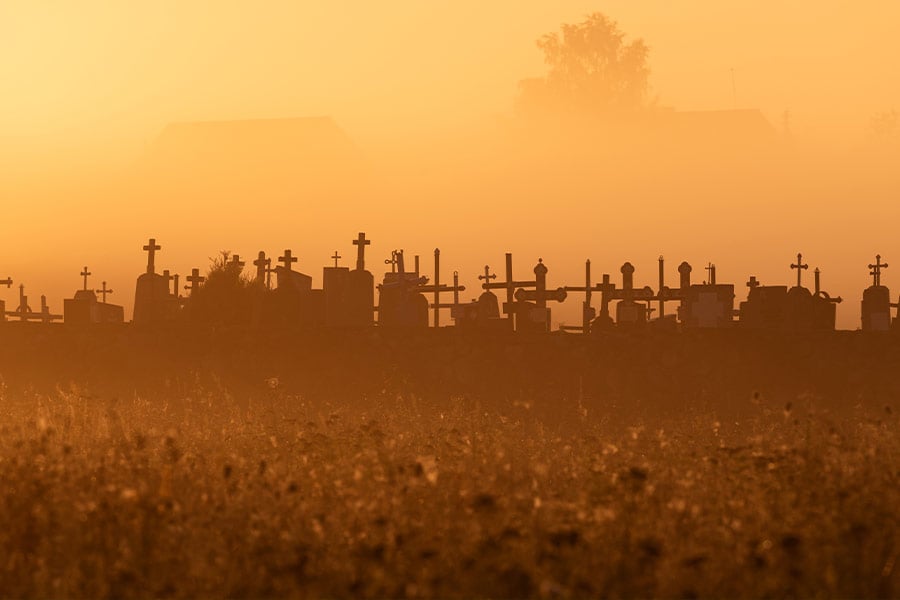After the Hour of Our Death: A deep dive on the faithful departed, cremation, and eulogies

(NTC photo illustration/Juan Guajardo)
The first half of the old idiom coined by Christopher Bullock in 1716, “‘Tis impossible to be sure of anything but death and taxes,” certainly resounds more loudly this time of year.
The seasons of fall and winter call to mind our fleeting time on earth, and what’s more, the liturgical calendar of the Catholic Church has major feast days such as All Saints and All Souls to remind us of “the world to come.” The Church also dedicates November to the Holy Souls in Purgatory, reminding us to pray for those who have gone before us.
So, yes, the Church places great emphasis on death. But for good reason: Christians believe that humans are made of body and soul, created in the image and likeness of God. Thus, Catholics should show deep respect to both body and soul during and after death. How do we do that? The NTC dug deep into Church history and spoke with local priests to find out.
Body and eternal soul
St. Paul wrote to the Corinthians, “Do you not know that your body is a temple of the Holy Spirit within you, whom you have from God, and that you are not your own?” (1 Corinthians 6:19). He follows that up in his letter to the Romans, “If, then, we have died with Christ, we believe that we shall also live with Him” (Romans 6:8).
In unequivocally declaring, “I look forward to the resurrection of the dead, and the life of the world to come,” the Nicene Creed, an authoritative doctrinal statement of the Church, also points to the reality of not just body and soul – but an immortal soul.
Current Catholic teaching reinforces that of the early Church. Pope Francis, in a 2015 address to families, said while the death of a loved one is “heart rending,” it’s important to remember that “our loved ones have not disappeared into dark nothingness. Hope assures us that they are in God’s good and strong hands. Love is stronger than death.”
Since both body and soul are integral to the human person, the Catholic funeral service requires reverence to both the body and soul of the deceased. Father Thu Nguyen, diocesan director of liturgy and worship, said, “Funerary rites according to the Church’s teachings help us acknowledge the reality of the death and await the final judgment and resurrection of the glorified body, body and soul, for eternal [life].”
Therefore, the Church teaches that through funerary rites, we not only strengthen our hope and comfort the bereaved, but we also bury the deceased’s bodily remains with the respect and care befitting what was a Temple of the Holy Spirit.
Honoring the body
“Human remains have dignity and respecting them is a way of affirming our faith in the resurrection,” Father Tim Thompson, pastor of Immaculate Conception Parish in Denton, explained. “The Church’s concern is that the resurrection not be denied.”
Although burying the body of the deceased remains preferable because it shows a greater respect toward the deceased, in 1963 the Vatican issued the instruction Piam et Constantem, which explained that either burial or cremation is allowed as long as the belief in the resurrection is upheld and the remains of the faithful departed are respected: “Cremation does not affect the soul nor prevent God’s omnipotence from restoring the body; neither, then, does it in itself include an objective denial of the dogmas mentioned.”
Fr. Nguyen referred to the appendix in the Order of Christian Funerals, which states: “The cremated remains should be buried in a grave or entombed in a mausoleum or columbarium. The practice of scattering cremated remains on the sea, from the air, or on the ground, or keeping cremated remains in the home of a relative or friend of the deceased are not the reverent disposition that the Church requires.”

A view of the columbarium at Good Shepherd Parish in Colleyville. A columbarium is one way to respectfully store urns of cremated remains. (NTC/Juan Guajardo)
The instruction Ad Resurgendum cum Christo, regarding the burial of the deceased and the conservation of the ashes in the case of cremation, published by the Vatican in 2016, gave further reasons for these specifications:
“The reservation of the ashes of the departed in a sacred place ensures that they are not excluded from the prayers and remembrance of their family or the Christian community. It prevents the faithful departed from being forgotten, or their remains from being shown a lack of respect, which eventually is possible, most especially once the immediately subsequent generation has too passed away.”
Fr. Thompson added, “The Church wants a sacred place to lay remains, that it be permanent, and that one’s remains are not kept as some sort of memento of the departed.”
He continued, “Human beings are not objects and should not be treated as objects for either work or pleasure. Human remains have a dignity which comes from that, though it is not the same. Bodies are often donated to science and are used for scientific purposes, and that is acceptable because it advances human knowledge and good. But bodies are never treated as a commodity to be used for any purpose. Mementos seem to be trivializing the dead.”
In the case of donating one’s body to science, it is important to note that after the laboratory studies the body, the family should receive the remains and see to their proper burial.
Fr. Nguyen further distinguished between venerating the bodies of saints and treating bodies as keepsakes: “Relics are venerated and respectfully used in witnessing the holiness that God bestowed in this person.”
Echoing St. Paul’s admonishment that we are “not our own,” Fr. Nguyen continued, “For a person to have their loved one’s parts for sentimental or other reasons is not appropriate. Along the same lines, people [mistakenly] think that their bodies belong to them, and they can do anything they want with them while still living.”
To be clear, the Church’s decrees are about respect and honor, and God’s power to resurrect is not affected by our actions. The Christian apologist Marcus Minucius Felix, writing in either the second or third century, recalled a Christian argument that even burnt or mutilated bodies can be resurrected: “But who is so foolish…as to dare to deny that man, as he could first of all be formed by God, so can again be re-formed? Every body, whether it is dried up into dust, or is dissolved into moisture, or is compressed into ashes, or is attenuated into smoke, is withdrawn from us, but it is reserved for God.”
This is good news for the martyrs, some of whom have been burned at the stake or have been mutilated in other ways. According to the Catechism of the Catholic Church, “In death, the separation of the soul from the body, the human body decays and the soul goes to meet God, while awaiting its reunion with its glorified body. God, in His almighty power, will definitively grant incorruptible life to our bodies by reuniting them with our souls, through the power of Jesus’ Resurrection” (CCC 997).
On eulogies and funerals
The Church’s general rule discourages eulogies at Catholic funerals. The Vatican’s Order of Christian Funerals teaches that the funeral rite is meant to offer “worship, praise, and thanksgiving to God for the gift of the life which has now been returned to God…The Mass, the memorial of Christ’s death and resurrection, is the principal celebration of the Christian funeral.”
Fr. Thu explained, “The homily at the Mass is supposed to help the people to understand the message about body and resurrection. You’re using the sacred texts of the funeral rite to help [the mourners] understand the hope, the resurrection, and yes, the sorrow.”
The rationale is that eulogies may detract from that key message.
The Order of Christian Funerals does clarify that “a member or friend of the family may speak in remembrance of the deceased before the final commendation begins.” Usually, dioceses allow for a eulogy to be given at the vigil (or wake) or the reception.
Praying with (and for) the deceased
On November 1, the Church celebrates the Solemnity of All Saints. According to Fr. Nguyen, the feast recognizes “all saints, both unrecognized and recognized through the canonization process,” many of whom do not have a specific feast day on which we honor their lives and works.
Additionally, Fr. Thompson said, “The Feast of All Saints implies that the category of saint is more ample than we imagine.”

Crosses are seen at a Catholic cemetery in Belarus in the early morning. (Getty Images/iStockPhoto)
On the feast of All Souls, we commemorate and pray for the faithful departed who have not yet attained the beatific vision of heaven because they have not been cleansed from the stains of sin. Catholic doctrine teaches that these souls reside in purgatory where they are perfected before they enter heaven. By praying and offering Masses and good deeds for these souls, the faithful on Earth help them in this process.
In Scripture, the author of Hebrews referred to the martyrs and saints as a “cloud of witnesses” (Hebrews 12:1).
As Catholics, we believe the faithful departed pray with us, pray for us, and receive the benefits of our prayers for them. Fr. Thompson said, “We pray for God’s mercy for those who have died. What God actually does with such prayers is a mystery. We pray for one another while on earth; such prayers do not need to stop simply because we have passed on.”
Since the early Church, Christians have honored both the bodies and the souls of the faithful departed. A second century account of the martyrdom of St. Polycarp states, “the martyrs, as disciples and followers of the Lord, we worthily love on account of their extraordinary affection towards their own King and Master. We afterwards took up [Bishop Polycarp’s] bones, as being more precious than the most exquisite jewels, and more purified than gold, and deposited them in a fitting place....” Scriptural basis for praying for the dead is found in 2 Maccabees 12:38-44, as well as other places in the Old and New Testaments.
As we commemorate our deceased loved ones on All Souls and All Saints, may we find solace in their communion with the Lord. Someday we too will be in union with God and reunited with our loved ones. In the meantime, we can pray with them and for them. “For now, we see only a reflection as in a mirror; then we shall see face to face” (1 Corinthians 13:12).
By Kiki Hayden and Juan Guajardo
